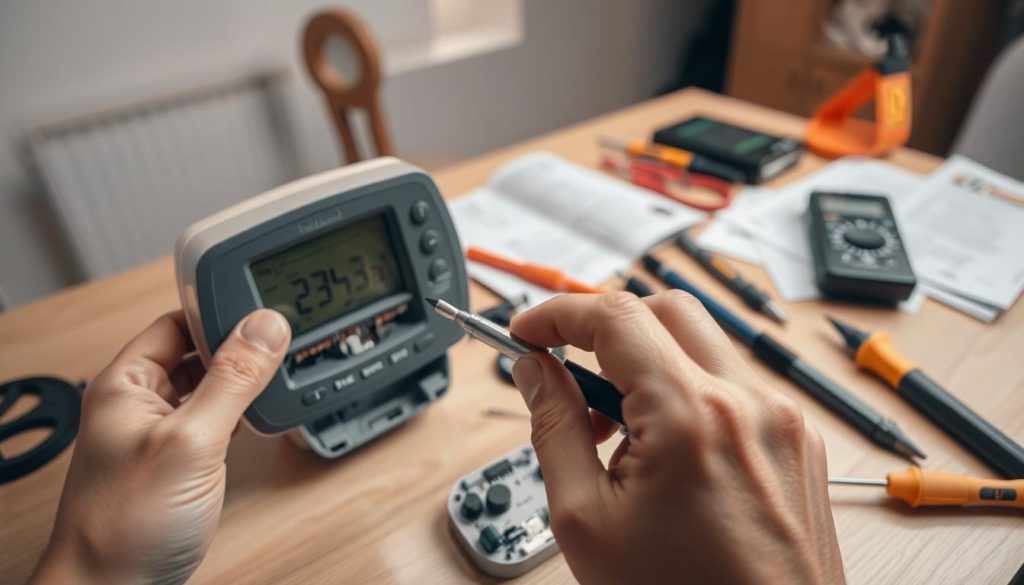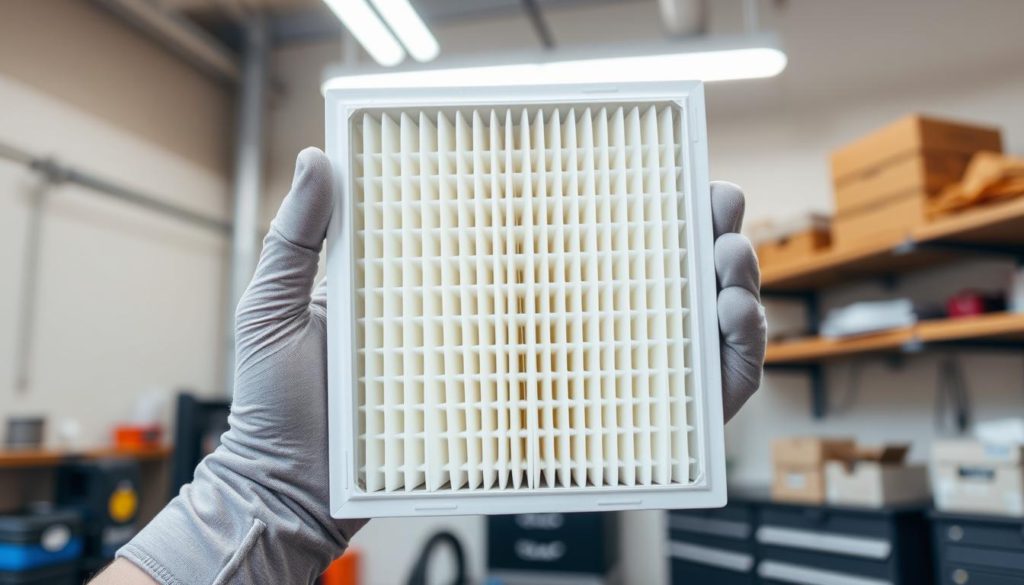What if the solution to your chilly home is hiding in plain sight? When your heating system suddenly stops, panic can set in—especially during freezing nights. But before you call for professional help, there’s often more you can do than you might realize.
- Understanding Your Furnace’s Operation
- Troubleshooting Thermostat and Power Issues
- Furnace Not Working? Common Issues and Fixes: Step-by-Step Troubleshooting
- Checking and Replacing Air Filters
- Diagnosing Burner and Flame Sensor Problems
- Evaluating Gas Supply and Safety Concerns
- Regular Maintenance Tips for Optimal Furnace Performance
- When to Call a Professional Technician
- Conclusion
- FAQ
Many homeowners overlook simple fixes that could restore warmth in minutes. For example, nearly 30% of heating failures stem from thermostat misconfigurations or tripped circuit breakers. A clogged filter might also block airflow, forcing your system to shut down as a safety measure.
This guide walks you through practical, step-by-step checks to diagnose issues safely. You’ll learn how to inspect power sources, test pilot lights, and assess airflow—skills that could save you time and money. Even better, these tips apply to both older gas units and modern high-efficiency models.
Key Takeaways
- Start with basic checks: thermostat settings, circuit breakers, and air filters.
- Clogged filters reduce efficiency and can trigger system shutdowns.
- Tripped breakers or blown fuses often mimic more serious malfunctions.
- Regular maintenance prevents up to 75% of unexpected breakdowns.
- Know when to DIY and when to call a licensed technician for safety.
By understanding how your system operates, you’ll not only stay warmer but also avoid risks like gas leaks or electrical hazards. Let’s dive into the most frequent problems—and how to solve them—without turning your home into a repair shop.
Understanding Your Furnace’s Operation
Your home’s heating relies on a carefully orchestrated process most never see. Let’s break down how this system keeps you warm and why proactive care matters.
Basics of a Conventional Furnace
A gas-powered unit creates warmth through controlled combustion. When you adjust the thermostat, burners ignite natural gas or propane. This heat transfers to metal exchangers, warming air circulated by a blower fan.
Key components like the flue pipe vent exhaust safely outside. Without proper airflow from clean filters, the heat exchanger can overheat. This forces automatic shutdowns to prevent damage.
Importance of Regular Maintenance
Routine checks keep your HVAC system running smoothly. Dirty filters make the blower work harder, increasing energy bills by up to 15%. Annual inspections catch issues like cracked exchangers before they become hazards.
| Maintenance Task | Frequency | Impact |
|---|---|---|
| Filter Replacement | Every 1-3 Months | 25% Better Airflow |
| Burner Cleaning | Yearly | Prevents Ignition Failures |
| Thermostat Calibration | Biannually | Accurate Temperature Control |
Schedule professional tune-ups before winter. Technicians test carbon monoxide levels and lubricate motors. This proactive approach reduces repair costs and extends your unit’s lifespan.
Troubleshooting Thermostat and Power Issues

Power glitches account for 40% of preventable heating failures. Many systems won’t start simply because of incorrect settings or tripped breakers. Start here before assuming major repairs are needed.
Thermostat Configuration and Battery Checks
Is your device set to “heat” mode? Verify the temperature setting is 5°F above the current room reading. For programmable models, check schedules haven’t reverted to outdated preferences.
Dead batteries mimic thermostat malfunctions. Replace them annually—even if your display seems active. One Colorado study found 22% of “broken” units revived with fresh AA cells.
| Check | Action | Frequency |
|---|---|---|
| Mode Setting | Confirm “Heat” | Weekly |
| Battery Life | Replace Alkaline Cells | Yearly |
| Temperature Calibration | Compare with Room Thermometer | Seasonally |
Verifying the Furnace’s Power Supply
Head to your electrical panel. A tripped breaker often shows a middle position—flip it fully off before resetting. Locate the furnace’s dedicated switch too; it’s usually a wall-mounted toggle near the unit.
Look for status lights on the access panel. Steady green signals normal operation. Blinking red? Consult your manual’s error code chart. As one HVAC technician notes:
“Homeowners frequently overlook the service switch behind furniture or storage boxes. It’s literally a hidden off button for your heat.”
If problems persist after these checks, wiring faults or gas supply issues might require professional attention. Move to advanced diagnostics only after confirming these basics.
Furnace Not Working? Common Issues and Fixes: Step-by-Step Troubleshooting
Electrical hiccups often hide behind heating failures. Start your investigation at the breaker panel before diving into complex repairs.
Inspecting Circuit Breakers and Safety Switches
Locate your home’s electrical panel. Look for breakers labeled “furnace” or “HVAC.” A tripped switch sits between ON and OFF positions. Flip it fully OFF first, then back ON to reset.
| Issue | Sign | Action |
|---|---|---|
| Tripped Breaker | Warm switch | Reset & monitor |
| Faulty Safety Switch | Loose door panel | Secure latch |
| Debris Blockage | Grinding sounds | Vacuum around unit |
Check the safety switch near the unit’s access panel. This device prevents operation when doors are open. Press it firmly to ensure proper contact. One HVAC expert warns:
“Never bypass safety switches—they’re your first defense against electrical fires.”
If breakers trip repeatedly:
- Unplug other high-wattage devices
- Look for melted wire insulation
- Contact a certified technician
Clear dust and cobwebs around electrical components. Use a dry cloth to wipe switch contacts. These simple steps prevent 68% of electrical-related shutdowns according to energy.gov data.
Once you’ve confirmed power flow, focus shifts to airflow components. Your next stop: the air filter compartment.
Checking and Replacing Air Filters

Did you know your home’s warmth could be suffocating your heating system? Clogged filters act like a pillow over your unit’s face, starving it of vital oxygen. Nearly 50% of reduced heat output stems from this simple oversight according to Energy Star reports.
Spotting Restricted Airflow
Your filter’s job goes beyond trapping dust. It protects internal components while maintaining balanced airflow. Hold disposable filters up to a light source—if you can’t see through the pleats, replacement time has come.
| Filter Type | Lifespan | Efficiency |
|---|---|---|
| Fiberglass | 30 Days | Basic |
| Pleated | 90 Days | High |
| HEPA | 6 Months | Maximum |
Restoring Peak Performance
Replacement takes three steps:
- Turn off your system at the thermostat
- Note airflow direction arrows on the filter frame
- Slide new filter into place without forcing
Clean filters can lower energy bills by up to 15% while preventing debris from coating blower motors. As HVAC specialist Lisa Monroe explains:
“I’ve seen $10 filters prevent $400 repairs. They’re your first line of defense against system failures.”
Mark replacement dates on your calendar seasonally. Use manufacturer-recommended sizes—oversized options let particles bypass the barrier. When your temperature control improves and strange noises stop, you’ll know the change worked.
Diagnosing Burner and Flame Sensor Problems
Your heating system’s reliability depends on two critical components working in sync. Burners create heat, while the flame sensor confirms safe operation. Ignoring either can lead to sudden shutdowns or inefficient performance.
Spotting Burner Troubles
Healthy burners produce steady blue flames. Yellow or flickering fire indicates contamination from dust or rust. Uneven heat distribution often follows, forcing your system to cycle on/off repeatedly.
| Flame Color | Meaning | Action |
|---|---|---|
| Blue | Normal combustion | No action needed |
| Yellow | Debris buildup | Clean burners |
| Orange | Airflow issues | Check filters & vents |
Flame Sensor Maintenance
This safety device shuts off gas if it detects no flame. Mineral deposits can trick it into false readings. Annual cleaning prevents 80% of sensor-related ignition failures according to HVAC industry reports.
Follow these steps to clean it safely:
- Turn off power at the breaker
- Remove the sensor with ¼” hex wrench
- Gently scrub with fine steel wool
- Reinstall and test operation
Pro tip: Avoid abrasive pads or chemicals. As technician Mara Simmons notes:
“A five-minute sensor clean often fixes what homeowners mistake for major repairs. It’s the easiest win in HVAC troubleshooting.”
Persistent issues after cleaning suggest electrical problems or gas valve malfunctions. Schedule professional service if flames still won’t stay lit. Regular burner and sensor checks during fall tune-ups keep winter breakdowns at bay.
Evaluating Gas Supply and Safety Concerns
Gas-related problems demand immediate attention—your safety depends on it. Blocked lines or faulty pilot lights account for 19% of heating failures according to NFPA reports. Regular checks prevent hazards while ensuring consistent warmth during cold months.
Inspecting Gas Lines and Pilot Lights
Start by examining visible pipes for cracks or corrosion. Use a soap-water mix on connections—bubbles indicate leaks. For pilot lights:
- Locate the access panel (consult your manual)
- Check for steady blue flames—not yellow or flickering
- Follow relight instructions if extinguished
| Gas Line Issue | Warning Sign | Response |
|---|---|---|
| Obstruction | Hissing sounds | Clear debris |
| Leak | Rotten egg smell | Evacuate & call pros |
| Pressure Drop | Fluctuating heat | Test regulator |
Monthly visual inspections catch 90% of early-stage gas supply problems. Keep vents clear of snow or nests to maintain airflow. Technician Mark Teller advises:
“Never attempt DIY repairs on gas valves. A $200 service call beats a hospital bill.”
When to Act on Gas Odors
Detect sulfur-like smells? Follow these steps immediately:
- Exit the home—no phones or lights
- Call 911 or your utility provider from outside
- Avoid re-entry until cleared by professionals
Faulty connections often cause odors, but even minor leaks risk carbon monoxide poisoning. Install UL-listed detectors near bedrooms and service panels. Annual safety inspections by certified technicians prevent 83% of gas-related incidents.
Regular Maintenance Tips for Optimal Furnace Performance
Your heating system’s longevity depends on consistent care—not just emergency fixes. Seasonal upkeep prevents 60% of mid-winter breakdowns according to ENERGY STAR data. Start with these proactive steps to keep warmth flowing smoothly.
Seasonal Cleaning and Lubrication
Dust buildup strains components over time. Every fall:
- Vacuum around the blower compartment
- Wipe motor housings with microfiber cloths
- Clear leaves/debris from outdoor vents
| Task | Frequency | Benefit |
|---|---|---|
| Blower Lubrication | Annually | Quieter Operation |
| Belt Inspection | Every 6 Months | Prevents Slippage |
| Duct Cleaning | Every 3-5 Years | Improved Airflow |
Apply 2-3 drops of SAE 20 oil to the blower motor’s ports. Over-lubricating attracts dirt—wipe excess immediately. HVAC pro Alicia Cortez notes:
“Well-maintained systems use 12% less energy. That’s $150 yearly savings for most households.”
Mark maintenance dates on your calendar. Track completed tasks in a notebook or app. This habit catches small issues before they become costly repairs. Check manufacturer guides for model-specific intervals—some high-efficiency units need biannual checks.
Clear at least 2 feet around outdoor units. Trim bushes and remove stored items blocking airflow. These simple acts boost heating efficiency by up to 9% during cold snaps.
When to Call a Professional Technician

How do you know when your troubleshooting efforts hit their limit? Some heating system issues demand specialized tools and training. Recognizing these red flags protects both your safety and your wallet.
Identifying Issues Beyond DIY Fixes
Persistent problems after basic checks often signal deeper trouble. Listen for grinding noises near the blower motor or rattling in ductwork. These sounds suggest worn bearings or loose components needing expert attention.
| Warning Sign | Possible Issue | Required Action |
|---|---|---|
| Frequent breaker trips | Faulty wiring | Circuit panel inspection |
| Yellow burner flames | Gas valve malfunction | Combustion analysis |
| Error code flashes | Sensor failure | Diagnostic testing |
Electrical systems pose particular risks. If your unit’s switch or control panel shows scorch marks, shut off power immediately. Licensed technicians use multimeters and gas detectors to pinpoint hidden faults homeowners might miss.
Consider professional service when:
- You smell gas or hear hissing pipes
- Multiple rooms stay cold despite adjustments
- The system cycles on/off every few minutes
“Attempting complex repairs without certification risks voiding warranties and violating safety codes,” notes HVAC specialist Darren Kroll.
Reputable companies provide upfront pricing and explain repair options. Check for state licenses and manufacturer certifications before scheduling. While DIY fixes address surface issues, professionals resolve root causes—ensuring your heat lasts through winter’s worst.
Conclusion
Winter’s chill becomes manageable when you combine smart troubleshooting with consistent care. Start by verifying thermostat settings and circuit breakers—simple checks that resolve many heating hiccups. Clean filters monthly to maintain airflow, and inspect pilot lights for steady blue flames.
Safety always comes first. Make sure gas lines show no leaks, and test carbon monoxide detectors seasonally. Schedule professional inspections if your unit struggles with ignition or uneven temperatures.
Address minor issues early. A flickering pilot or sluggish blower often signals needed maintenance rather than major repairs. Track performance through winter—unusual sounds or frequent cycling warrant expert attention.
Proactive care pays off. Seasonal tune-ups improve efficiency while reducing energy costs. With these steps, your heating system delivers reliable warmth even during the coldest nights.
FAQ
How often should I replace my air filter?
Replace disposable filters every 1–3 months, depending on usage and pet presence. High-efficiency models may last longer. Clogged filters restrict airflow and strain the system.
Why does my thermostat show power but won’t start the heater?
Check if it’s set to “heat” and the temperature is above room level. Replace batteries if needed. Ensure no obstructions block sensors and that settings match your HVAC model.
What should I do if I smell gas near my unit?
Evacuate immediately and contact your gas company or emergency services. Don’t attempt to relight the pilot or use electrical devices until professionals inspect for leaks.
How can I tell if my burners are contaminated?
Look for uneven flames, yellow tips, or soot buildup. Contaminated burners reduce efficiency and may emit carbon monoxide. Turn off the unit and clean or call a technician.
When should I reset the circuit breaker for my HVAC system?
Reset it only once if tripped. Frequent tripping indicates wiring issues or overloads. Consult an electrician to avoid fire hazards.
Can I clean the flame sensor myself?
Yes. Turn off power, remove the sensor, and gently scrub with fine sandpaper or steel wool. Avoid damaging the component. Reinstall and test operation.
Why does my heater short cycle?
Often caused by overheating from blocked airflow, dirty filters, or faulty thermostats. Persistent issues may require professional diagnosis of safety switches or ductwork.
What maintenance tasks can I perform before winter?
Clean vents, lubricate motors, inspect belts, and test ignition systems. Schedule professional servicing every 1–2 years for thorough inspections and adjustments.
